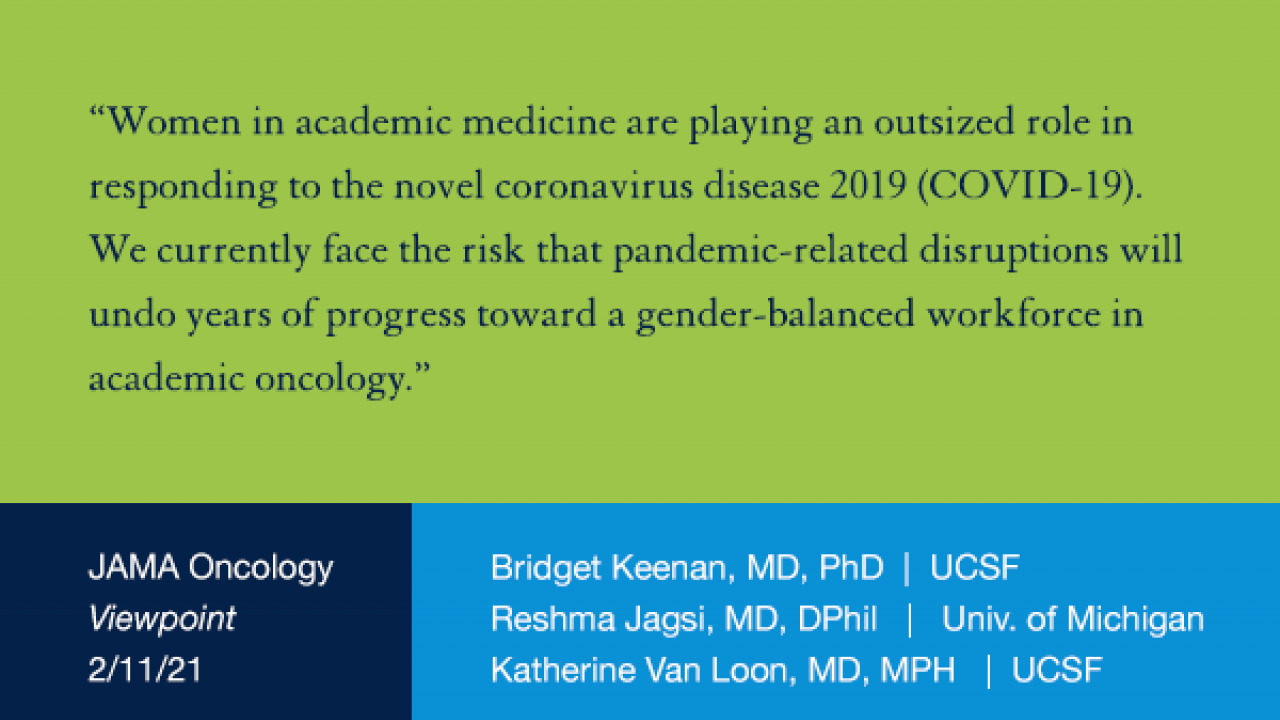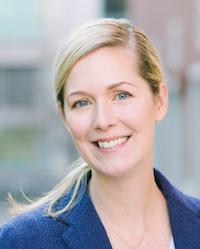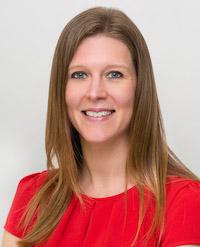
Women in academic medicine are facing the prospect of career setbacks as a result of the COVID-19 pandemic. Katherine Van Loon, MD, MPH, Associate Professor of Clinical Medicine and Director of the HDFCCC Global Cancer Program; and Bridget Keenan, MD, PHD, a Clinical Fellow of Hematology/Oncology, recently published a Viewpoint article in JAMA Oncology addressing the issue and offering solutions for institutions. In a Q&A, they offer additional insights and discuss the formation of a new HDFCCC Gender Equity Task Force.
What prompted you to write the Viewpoint article for JAMA Oncology? How early into the pandemic did you start experiencing or noticing the gender-based inequities and tensions you discuss in the article?
Van Loon: I was previously cognizant of and sensitized to gaps in gender equity in medicine and the biomedical sciences, but the pandemic brought this issue front and center for me. I have two early elementary school-age kids (5 and 9) who have been home since last March when the San Francisco Unified School District shifted to distance learning.
In the summer, UCSF laid off a number of academic assistants and medical scribes. These layoffs came without warning, affecting numerous faculty and especially the staff who lost jobs in the midst of an economic downturn. Like many others, I was already working around the clock to sustain my clinical responsibilities, research portfolio, and leadership of the Global Cancer Program, along with the added caregiving responsibilities. The loss of consistent, experienced support added a huge amount of non-academic work to my plate. Since then, UCSF has begun backfilling those lost positions, but there are additional time demands related to training. Around the same time, UCSF announced a leave policy allowing primary caregivers to accept “donations” of vacation time from colleagues.

Katherine Van Loon, MD, MPH
This series of events was really a wake-up call for me. The offer to take a “donated” leave as one of the primary solutions seemed so disconnected from the reality of this job. It might have been well-intentioned, but it was clumsy. Around this time, I also started talking to junior and mid-level female faculty who were struggling to balance academic and clinical productivity with caregiving responsibilities at home. Despite the challenges, none of us were considering taking leave, as that would mean transferring care of our critically ill, highly anxious patients to other faculty in the midst of a pandemic. An unwanted leave is not a “donation,” but rather this seemed like a guaranteed one-way ticket out of academia. While I acknowledge this has been the necessary path for some, it wasn’t a viable solution for many.
Women in healthcare have played a significant role in the pandemic and comprise a large portion of the workforce. The fact is that we are not easily replaceable. As I saw all of this unfolding, there were a few early articles published that were beginning to describe the problem that women in academia are facing. I felt strongly that we needed to provide proactive solutions to support women to be able to sustain careers in academic medicine. Otherwise, we face a dramatic backslide, and the gender gaps that pre-dated the pandemic will be exacerbated. At that point, I reached out to Dr. Keenan who has expertise in gender equity issues and asked her to partner with me in authoring this manuscript.

Bridget Keenan, MD, PhD, Oncology Fellow
Keenan: The pandemic has unmasked many aspects of our society where inequities already existed, such as racial and gender disparities. However, it also provides an opportunity to better recognize and understand these issues, and formulate a plan to act rather than allow disparities to widen. If we do not take action now, we may backslide on years of progress.
Early on in the pandemic, I saw male scientists and physicians dominating the discussion around COVID-19, with more “manels” (panels with only male representation) at scientific meetings and in mainstream media. There is an assumption that women and those with primary caregiving responsibilities may want to take a step back from work due to pandemic-related disruptions, but we need to counter those biases and develop solutions to support those who have been affected without asking them to take a step back.
The article highlights entrenched disparities and systemic biases faced by women in academic medicine regardless of special circumstances like a pandemic. Can you describe these? At what point in their careers do women in academic medicine begin facing these?
Keenan: Women comprise half or more of medical school matriculants in recent years but account for a smaller percentage of faculty members, with the lowest percentages at upper levels of healthcare leadership such as medical school deans and department chairs. This phenomenon is known as the “leaky pipeline.” More recently, another analogy - the “broken rung” - has suggested that inequities start with the first faculty appointment and lead to gaps in higher levels of healthcare leadership.
If women are started out at lower pay, faculty rank, or without similar leadership opportunities, then it becomes nearly impossible to catch up. As a trainee, I have been fortunate to have both fantastic male and female mentors who have supported my career. However, it has been simultaneously discouraging to see few women in leadership roles as role models for my own career as a physician-scientist.
Van Loon: There was a great article published last year in The Journal of Women’s Health on how the mid-career woman in academic medicine becomes invisible. Many highly qualified women fall out of academic medicine as they mature from early career to mid-career stages. During early career stages, female trainees and junior faculty receive professional attention and professional development focus.
But attitudes shift as women advance to mid-career, and the intentional attention and support wane. Letters of recommendation shorten, and the language used becomes less powerful. Speaking invitations at national meetings and academic ground rounds diminish. Women are less likely to be formally introduced on the speaker’s podium. Women are less likely to receive career achievement awards and are under-represented on editorial boards and national panels. The impact is cumulative, and women eventually get discouraged and leave. This phenomenon perpetuates the status quo of gender inequities in academic medicine, particularly at senior levels.
Would you share some personal experiences?
Van Loon: I’d like to share two types of experiences. The first is about my experience in balancing home and work responsibilities. And the second one is about what happens when women speak up.
I have had the good fortune to have mentors and sponsors in my career who have consistently been my champions. Interestingly, they are all senior males, who I believe truly recognize talent and hard work through a gender-blind lens. But I wouldn’t say that I have had a mentoring relationship where I am openly discussing the challenges of balancing career and a young family.
The difference now is that we’re seeing one another inside our homes during the workday, and there’s a direct window into the lives of working parents with school-age children. The good news is that working from home has increased attention and public dialogue about what working moms are juggling. The bad news is that this increased visibility may mean women are being asked to take on fewer leadership responsibilities. I have definitely received a few emails telling me I am “too busy” to take something on. But shouldn’t that be my decision? It’s important that opportunities are assigned based upon merit, not based upon biased assumptions about what someone can or cannot manage.
Second, finding my voice as I have become more senior and bear more responsibility has been one of my greatest challenges. At times, when I have advocated for myself or for something important, I have been told I am “intimidating” or that I should “complain less.” Would those same words be used to describe a male in the same situation?
Studies have shown that female professionals, even those working at very senior levels, speak less in meetings as an act of self-preservation. But with seniority and leadership roles come the responsibility to speak up. When I see that a trainee, junior faculty member, or a staff member is not being treated fairly, I know it’s my responsibility to advocate for him/her. I need to be willing to step forward to ensure that my mentees have all of the opportunities available so that their careers don’t suffer. But developing this voice and learning how to use it effectively is an art. And sadly, there are still instances in which certain audiences are more receptive to hearing the same message from a man.
Keenan: I became interested in gender equity issues as a MD-PhD student. My fellow students and I studied data from the Association of American Medical Colleges and saw that women were less likely to apply to top-tier medical scientist training programs (compared to other ranked programs). We also found that women’s careers lagged behind those of male counterparts from our own institution – which was shocking.
We were motivated to change these statistics and formed a group of MD-PhD students working to increase female recruitment and leadership skills. As a trainee, I have been subject to micro-aggressions – the most common is the assumption that I am a medical student or a nurse. Repeatedly, patients or other medical teams would select to address the male medical student rather than me. These “micro”-aggressions are not actually so small; they add up and affect your confidence. I continued my interest in gender equity by founding a leadership symposium for female internal medicine residents and then followed that project up with another to design a leadership series for women trainees across the university. However, the further I have gone in my training, the more I have realized that the onus should not be on “fixing” women physicians but on fixing a broken system. That prompted writing about some of the institutional solutions we proposed in our article.
Your article notes that during the pandemic publications with women as first authors declined. That seems like a rapid contraction. Can you talk more about that and why it is significant?
Keenan: Our co-author, Dr. Reshma Jagsi of the University of Michigan, studied authorship on COVID-19-related articles and found that women with first authorship was less than expected based on authorship in the same journals for the previous year. Other studies have demonstrated a similar trend in pre-prints, with male authorship increasing at a greater rate than female authorship.
This disturbing trend could reflect the women scientists and clinicians who were pulled out of the workforce as the pandemic began, or who were at reduced effort. Studies published prior to the pandemic of academic physicians, including a study of high-achieving K awardees, show that women spend more time on household tasks (up to 8.5 hours more per week) than their male peers. Thus, during the pandemic, extra care-giving burdens placed on women could have led to disproportionate academic productivity. However, we also can’t discount the role of bias, and the phenomenon Dr. Van Loon referred to about the too-common assumption that women are “too busy” balancing home and work to take on new projects or leadership roles.
Please talk about some of the pragmatic solutions you propose for the inequities you’ve identified, and which ones might be a good fit for UCSF sooner rather than later?
Van Loon and Keenan: Right now, the overwhelming focus of the response to the impact of the pandemic on gender equity seems reactive. Policies are being developed at the institutional level to address how promotion schedules are handled during a period of reduced productivity. We are talking about “stopping the clock.” Inherent in this is an assumption that the setbacks women face as a result of the pandemic cannot be prevented.
I would like to see UCSF pivot to thinking about how we can proactively work to sustain the careers of women in academic medicine and minimize the setbacks and the long-term regressive impact. We need to identify the various reasons why women depart from this career path and figure out how to bolster women leading up to those points.
Resources
To accomplish this, we need to understand what gender equity actually means. By definition, gender equity is “fairness of treatment for women and men, according to their respective needs. This may include equal treatment or treatment that is different but which is considered equivalent in terms of rights, benefits, obligations and opportunities.” Requirements for success are inherently different for different individuals, depending on the professional role and competing demands. The UCSF Child and Dependent Care Task Force has been critical in addressing the added strains of caregiving that came with the pandemic, but I think this is only one component of a multifaceted problem. We also need to think about how to sustain and enhance, not interrupt, academic productivity. This is critical to improving representation of women in leadership roles.
We need to help primary caregivers work as efficiently as possible. We should consider how to support administrative tasks and the escalating demands of documentation in electronic medical records, which detract from academic productivity. We need to make sure that teaching and service responsibilities are distributed with an eye towards equity. We need interventions to reduce burnout, which is extraordinarily high among women in academic oncology.
The light is appearing at the end of the tunnel for the COVID-19 pandemic with the approved vaccines. However, “temporary” setbacks during the pandemic may have long-lasting impact on careers. During this unprecedented time, we should be supporting those in the healthcare workforce most impacted by the pandemic. Some solutions are more feasible than others to implement rapidly. For one, gender bias training could be mandatory so that stress-based, biased decision-making is less rampant.
The publication of the paper coincides with the formation of a Cancer Center Gender Equity Task Force that you will lead. How did the task force come about?
Van Loon: I originally reached out to Dr. Alan Ashworth to request a letter of support for an application I was submitting to the WomenLift Health Leadership program. This program aims to expand the power and influence of women in global health and catalyze systemic change to achieve gender equality in leadership. I was originally planning to apply to advance the work that I am doing to promote female leaders in global cancer control. In my request for a letter of support, I also provided a little background about why gender equity felt so personally important to me at this moment.
Dr. Ashworth responded to my email within a few minutes, not just to affirm his support, but he asked to have a discussion. He specifically wanted to understand the issues women are facing within the HDFCCC. In this discussion, I provided a brief overview of some recent challenges as well as some specific examples of opportunities for change. At the end of that conversation, we agreed to form a Gender Equity Task Force to systemically address prevailing issues at HDFCCC.
My project for the WomenLift Health Leadership Program evolved into a proposal to empower women leaders in academic oncology, globally and locally. I think that Dr. Ashworth’s immediate response reflects his commitment to equity at HDFCCC, and I am honored to have this opportunity. Dr. Keenan will join me as co-leader of this task force, bringing significant expertise on gender equity issues for women in science and medicine.
What do you envision the task force will address, and how will you put forward recommendations?
Van Loon and Keenan: We have outlined what some of the gender inequities are at a national level using data we cited in our paper. We also need to spend some time collecting data on the experiences of people affiliated with the HDFCCC. Data is a powerful way to tell any story and will be a critical component. Next, we need to identify root causes behind the inequities. We will then tackle the issues that are most salient for the HDFCCC faculty, staff, and trainees. In addition, we will look to peer institutions to benchmark successful interventions. Our goal is to generate solutions that are pertinent to the issues we identify and to ensure that this work is operationalized.
Last year, the Cancer Center also formed an Anti-Racism Committee to augment the efforts throughout UCSF. How do you envision the Gender Equity Task Force working with this group?
Van Loon: Women are under-represented in academic medicine, and women of color are even more under-represented. These statistics are even further exacerbated in leadership roles. The perspective piece published last week in The Lancet highlights the systematic neglect of Black women in the health professions and the need for restructuring of systems. Both of these task forces are critically important and highly relevant right now. We will need to work together to ensure that our work is synergistic. There are many ways in which racial equality and gender equality are intertwined, and we need to advocate for both.
Keenan: Gender and racial equity should be parallel efforts and these task forces should seek to work together. Sexual orientation, gender identity, and race/ethnicity are all aspects of our identities (just to name a few). Inequities may be compounded for those with intersectional identities. We need to make sure all efforts to overcome inequity are inclusive for any and all groups that have been under-represented in the healthcare workforce and in leadership roles.
*If you are interested in serving as a member of the Gender Equity Task Force at HDFCCC, please email Amanda Sibley. Please include a brief statement of your motivation for participating. People of all gender identities are welcome.